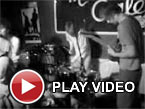Group Doueh, "Beatte Harab"
 For their third LP for Sublime Frequencies, the group has put together a stunning collection of trance-inducing works. Yet, there are two things that set Beatte Harab apart from Group Doueh’s previous albums. The recording quality is a step above the others: granted the overall quality is not high fidelity but gone is the murk so all the instruments and singers can be heard distinctly. Secondly, Doueh himself has moved more into the background. His deft touch of the fretboard is undiminished but he confines himself to the back of the mix, his playing developing the overall shape of the music without dominating the other performers.
For their third LP for Sublime Frequencies, the group has put together a stunning collection of trance-inducing works. Yet, there are two things that set Beatte Harab apart from Group Doueh’s previous albums. The recording quality is a step above the others: granted the overall quality is not high fidelity but gone is the murk so all the instruments and singers can be heard distinctly. Secondly, Doueh himself has moved more into the background. His deft touch of the fretboard is undiminished but he confines himself to the back of the mix, his playing developing the overall shape of the music without dominating the other performers.
The album is mainly given over to the vocals which sound superb compared to some of the distorted recordings on the earlier LPs. Halima Jakani’s voice still manages to send my speakers into contortions; her singing sounding more impassioned on the title track (a version of which also appeared on the group’s previous album). Throughout Beatte Harab Jakani stands out compared to the other elements of the music; her voice silhouetted by the rest of Group Doueh.
That is not to say that the other musicians are relegated to a mere backing band. On "Kar Lakhaal," Doueh leads them through a fantastic instrumental piece that starts off contemplative and controlled but soon sprouts wings to fly into directions unknown. Leaving down his electric guitar for the tinidet (a banjo-like instrument), the music on Beatte Harab has a very different character to what I have heard previously from Doueh and his players. When not using electric guitar and easing up on the synthesisers that punctuated their other releases, it highlights how little Group Doueh deviates from traditional forms. While this is still a terrific album, for the most part I would be unable to guess it was Group Doueh without the album sleeve in front of me.
However, the classic Doueh sound turns up from time to time; Doueh’s fretwork on "Lehi Teyilu" being a particularly stunning example of his skill. Listening to such exquisite musicianship throughout Beatte Harab, I repeatedly imagine how this music must sound live. It is not a huge stretch considering all of the Group Doueh recordings seem to be one take. I know they are about to embark on a tour of the UK but opening up the gatefold sleeve and seeing a gorgeous photo (perhaps a video still?) of the audience during a Group Doueh performance in what I must assume is the Western Sahara, I cannot help but wish to be dropped smack bang in the middle of it all. It is a bit like listening to old bootlegs of The Velvet Underground or Throbbing Gristle, strange as it may seem. This is music very much born out of a landscape and a culture that cannot be fully appreciated when transplanted out of its environment. Yet equally I wonder if the mystery also adds to the experience, whether the evocative photos that line the sleeves create a world in my mind that is not really out there.
In any case, being able to hear this music at all is something to be thankful for as Group Doueh continues to inspire awe and delight. Hopefully, Sublime Frequencies do not tarry when it comes to putting out the CD of this (for the time being) vinyl only release. As lovely as the LPs are, Group Doueh deserve a bigger audience than the limited edition vinyl crowd.
 



